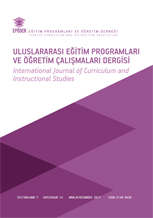The COVID-19 Pandemic, University Students in Turkey, and Emergency Online Learning
Abstract
In this study, we determined how university students in Turkey, a developing country, were able to transition into emergency online learning during COVID-19, what challenges they faced, and the positive experiences that may have come out of this process. We also explored how their positive and negative emotional states may have changed as a result of COVID-19. The sample included 125 students studying in different universities across Turkey who answered an online questionnaire. Results indicated that students’ positive emotions decreased and negative emotions increased significantly. Results also showed that the students experienced the following challenges during emergency online learning: not benefiting from online classes, lack of motivation in following online classes, problems related to family life and finances, increased levels of homework, and problems related to Internet access. In terms of positive experiences, students indicated spending more quality time with family, time for hobbies and personal development, examining life and personal existence, increase in the level of academic development due to homework assignments, and increase in grade-point-average. Students’ answers also revealed that their instructors may have been going through some difficulties as well. Students highlighted complaints related to their instructors’ lack of interest in teaching, not holding lectures, or not uploading class notes or slides, and their difficulty in getting in touch with their instructors. Implications are discussed.
Downloads
References
Aguilera-Hermida, A. P. (2020). College students’ use and acceptance of emergency online learning due to COVID-19. International Journal of Educational Research Open, 1. DOI: https://doi.org/10.1016/j.ijedro.2020.100011
Basilaia, G., Dgebuadze, M., Kantaria, M., & Chokhonelidze, G. (2020). Replacing the classic learning form at universities as an immediate response to the COVID-19 virus infection in Georgia. International Journal for Research in Applied Science & Engineering Technology, 8(III), 101-108.
Bower, M. (2019), Technology‐mediated learning theory. British Journal Education Technology, 50, 1035-1048. doi:10.1111/bjet.12771
Brondani, M., & Donnelly, L. (2020). COVID‐19 pandemic: students’ perspectives on dental geriatric care and education. Journal of dental education, 84(11), 1237-1244.
Chick, R.C., Clifton, G.T., Peace, K.M., Propper, B.W., Hale, D.F., Alseidi, A.A., & Vreeland, T.J. (2020). Using technology to maintain the education of residents during the COVID-19 pandemic. Journal of Surgical Education,77(4), 729-732. https://doi.org/10.1016/j.jsurg.2020.03.018
Cojocariu, V.M., Lazar, I., Nedeff, V., & Lazar, G. (2014). SWOT analysis of e-learning educational services from the perspective of their beneficiaries. Procedia-Social and Behavioral Sciences, 116, 1999–2003.
Crawford, J., Butler-Henderson, K., Rudolph, J., Malkawi, B., Glowatz, M., Burton, R.,
Magni, P., & Lam, S. (2020). COVID-19: 20 countries’ higher education intra- period digital pedagogy responses. Journal of Applied Learning & Teaching, 3(1), 1–20.
Creswell, J. W., & Miller, D. L. (2000). Determining validity in qualitative inquiry. Theory into Practice, 39(3), 124-130.
Denzin, D. K. (1989). The research act: A theoretical introduction to sociological methods (3rd Ed.). Dunfermline: Prentice Hall College Div.
Dhawan, S. (2020). Online learning: A panacea in the time of COVID-19 Crisis. Journal of Educational Technology System, 49(1), 5-22. DOI: 10.1177/0047239520934018
Engelmann, P., & Bannert, M. (2019). Fostering students' emotion regulation during learning: Design and effects of a computer-based video training. The International Journal of Emotional Education, 11(2), 3-16.
Filius, R. M., Kleijn, R. A. M., Uijl, S. G., Prins, F. J., Rijen, H. V. M., & Grobbee, D. E. (2019). Audio peer feedback to promote deep learning in online education. Journal of Computer Assisted Learning, 35(5), 607-619. https://doi.org/10.1111/jcal.12363
Flaherty, C. (2020). Faculty stress is now chronic. Inside Higher Education. Downloaded from https://www.insidehighered.com/news/2020/11/19/faculty-pandemic-stress-now-chronic
Heckel, C., & Ringeisen, T. (2019). Pride and anxiety in online learning environments: Achievement emotions as mediators between learners' characteristics and learning outcomes. Journal of Computer Assisted Learning, 35, 667– 677.
Hodges, C., Moore, S., Lockee, B., Trust, T., & Bond, A. (2020). The difference between emergency remote teaching and online learning. Educause review, 27, 1-12.Hodges
Lassoued, Z., Alhendawi, M., & Bashitialshaaer, R. (2020). An exploratory study of the obstacles for achieving quality in distance learning during the COVID-19 pandemic. Education Sciences, 10(9), 232.
Liguori, E. W., & Winkler, C. (2020). From offline to online: Challenges and opportunities for entrepreneurship education following the COVID-19 pandemic. Entrepreneurship Education and Pedagogy, 3(4), 346-351. https://doi.org/10.1177/2515127420916738
Littlefield, J. (2018). The difference between synchronous and asynchronous distance learning. https://www.thoughtco.com/synchronous-distance-learning-asynchronous- distance-learning-1097959
Long, T., & Johnson, M. (2000). Rigour, reliability and validity in qualitative research. Clinical effectiveness in nursing, 4(1), 30-37.
McBrien, J. L., Cheng, R., & Jones, P. (2009). Virtual spaces: Employing a synchronous online classroom to facilitate student engagement in online learning. The International Review of Research in Open and Distributed Learning, 10(3), 1–17.
Müller, A. M., Goh, C., Lim, L. Z., & Gao, X. (2021). COVID-19 Emergency eLearning and Beyond: Experiences and Perspectives of University Educators. Education Sciences, 11(1), 19.
Qu, L. (2020). Online learning: When class is just a click away. Duke Kunshan University. https://www.scmp.com/tech/ enterprises/article/3048891/chinas-traditional-schools- embrace-online-learning-coronavirus
Rieley, J. B. (2020). Coronavirus and its impact on higher education. Retrieved from: https://www.researchgate.net/post/Corona_Virus_and_its_impact_on_higher_education
Singh, V., & Thurman, A. (2019). How many ways can we define online learning? A
systematic literature review of definitions of online learning (1988-2018). American
Journal of Distance Education, 33(4), 289–306.
Song, L., Singleton, E. S., Hill, J. R., & Koh, M. H. (2004). Improving online learning:
Student perceptions of useful and challenging characteristics. The Internet and Higher
Education, 7(1), 59–70.
Toquero, C. M. (2020). Challenges and opportunities for higher education amid the COVID-19 pandemic: The Philippine context. Pedagogical Research, 5(4), 2-5.
Trout, B. S. (2020). The Coronavirus-induced transition to online learning: Perceptions and intentions of first-time online students. Quarterly Review of Distance Education, 21(1), 1-12.
UNESCO. (2020). COVID-19 Educational disruption and response. https://en.unesco.org/themes/education- emergencies/coronavirus-school-closures
Yıldırım, A. & Şimşek, H. (2013). Sosyal bilimlerde nitel araştırma yöntemleri. Ankara: Seçkin Yayınları.
Yuksek Ogrenim Kurumu (YOK). (2020). YÖK’ten Koronavirüs (COVID-19) hakkında yükseköğretim kurumlarında alınacak tedbirlere ilişkin öneriler. Accessed: March,06, 2020: tarihinde https://covid19.yok.gov.tr/alinan-kararlar





